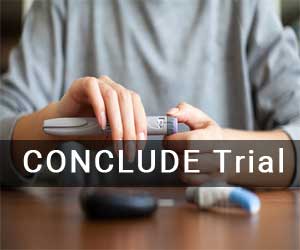- Home
- Editorial
- News
- Practice Guidelines
- Anesthesiology Guidelines
- Cancer Guidelines
- Cardiac Sciences Guidelines
- Critical Care Guidelines
- Dentistry Guidelines
- Dermatology Guidelines
- Diabetes and Endo Guidelines
- Diagnostics Guidelines
- ENT Guidelines
- Featured Practice Guidelines
- Gastroenterology Guidelines
- Geriatrics Guidelines
- Medicine Guidelines
- Nephrology Guidelines
- Neurosciences Guidelines
- Obs and Gynae Guidelines
- Ophthalmology Guidelines
- Orthopaedics Guidelines
- Paediatrics Guidelines
- Psychiatry Guidelines
- Pulmonology Guidelines
- Radiology Guidelines
- Surgery Guidelines
- Urology Guidelines
Blood sugar control: Insulin degludec better than insulin glargine, reveal results from CONCLUDE trial

Low blood sugar or hypoglycemia is the most common side effect of insulin glargine -- used for the management of diabetes. Now, a recent study seemed to have found a solution to this problem in the form of Tresiba (insulin degludec). According to findings from head-to-head CONCLUDE trial, Tresiba decreased the risk of low blood sugar at a significantly lower HbA1c level, compared with commonly used insulin glargine in people with type 2 diabetes.
The findings were presented at the 55th Annual Meeting of the European Association for the Study of Diabetes (EASD 2019) in Barcelona, Spain.
The findings are significant as hypoglycaemia, if not treated properly, can cause a range of symptoms including confusion, trembling, sweating, increased heart rate, difficulty with concentration and speech, and in severe cases it can lead to seizures, coma or even death.
The CONCLUDE clinical trial compared the risk of hypoglycaemia with Tresiba vs insulin glargine U300 in 1,609 adults with type 2 diabetes. Both treatments were administered once daily, with or without oral antidiabetic drugs (OADs), in insulin-experienced participants. Endpoints were assessed during a 36-week maintenance period and a total treatment period of up to 88 weeks.
The primary endpoint was the overall number of severe (defined as an event requiring third party assistance) or blood glucose confirmed (<3.1 mmol/L) symptomatic hypoglycaemic episodes during the maintenance period. Secondary hypoglycaemia endpoints included the number of nocturnal symptomatic and the number of severe hypoglycaemic events during the maintenance period, as well as basal insulin dose (U) at end of treatment. Other endpoints included change from baseline to end of treatment in HbA1c and fasting plasma glucose (FPG) level and all three hypoglycaemia endpoints during the total treatment period.
Key findings of the CONCLUDE Trial include:
- The primary endpoint, the rate of overall symptomatic hypoglycaemia in the maintenance period of 36 weeks which was tested for superiority, was numerically lower but not statistically significant versus insulin glargine U300.
- The rate of overall symptomatic hypoglycaemia was statistically significantly lower in favour of Tresiba during the total treatment period of up to 88 weeks.
- Tresiba significantly reduced the rate of severe hypoglycaemia by 80% and nocturnal symptomatic hypoglycaemia by 37% when compared with insulin glargine U300 during the maintenance period, and by 62% and 43% respectively in the total treatment period when compared with insulin glargine U300.
- The proportion of participants experiencing hypoglycaemia was also significantly lower in favour of Tresiba during both the maintenance and total treatment periods for all hypoglycaemia endpoints.
- The reductions in rates and proportions of patients experiencing hypoglycaemia with Tresiba were seen alongside significant reductions from baseline in HbA1c (estimated treatment difference [ETD] -0.1%) and fasting plasma glucose (ETD -0.62 mmol/L).
- Tresiba showed a 12% lower insulin dose requirement with an end-of-trial mean daily insulin dose of 67U, compared with 73U for insulin glargine U300.
"Severe hypoglycaemia can be very worrying and potentially dangerous for people with diabetes and is important to consider as part of long-term diabetes care," said Dr Athena Philis-Tsimikas, CONCLUDE lead investigator and corporate vice president, Scripps Whittier Diabetes Institute. "The results of this trial reinforce the safety profile of Tresiba® as it demonstrated a significant reduction in severe hypoglycaemia compared to insulin glargine U300 alongside effective blood glucose control."
"We are delighted that the findings of the CONCLUDE trial support what we have seen previously across the Tresiba clinical development programme," Mads Krogsgaard Thomsen, executive vice president and chief science officer of Novo Nordisk, said in the company's press release. "These findings offer further confidence that Tresiba can help people with type 2 diabetes reduce their risk of hypoglycaemia, without having to compromise their treatment goals."
About Tresiba
Tresiba (insulin degludec) is once-daily basal insulin that provides a duration of action beyond 42 hours with a flat and stable glucose-lowering effect. Tresiba led to an effective reduction in HbA1c in clinical trials and showed a lower risk of hypoglycaemia in studies compared to insulin glargine U100, in particular in type 2 diabetes. It also provides a lower day-to-day variability in glucose-lowering effect versus insulin glargine U100 and insulin glargine U300. Tresiba received its first regulatory approval in September 2012 and has since been approved in more than 80 countries globally. It is commercially available in more than 61 countries.

Disclaimer: This site is primarily intended for healthcare professionals. Any content/information on this website does not replace the advice of medical and/or health professionals and should not be construed as medical/diagnostic advice/endorsement or prescription. Use of this site is subject to our terms of use, privacy policy, advertisement policy. © 2020 Minerva Medical Treatment Pvt Ltd